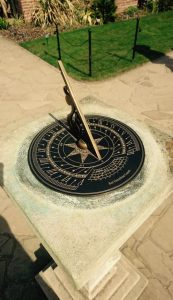Uncategorized
The History of Watchmaking: From Sundials to Smartwatches
The art and science of watchmaking have evolved significantly over centuries, shaping how we perceive time today. From ancient sundials to the cutting-edge technology of modern smartwatches, the journey of timekeeping reflects advancements in engineering, design, and human ingenuity. At 360bestelitend.com, we take a closer look at the fascinating history of watchmaking, exploring the pivotal moments that led to the creation of the precision timepieces we know and love today.
1. The Dawn of Timekeeping: Sundials and Water Clocks

The quest to measure time began long before the first mechanical watches were developed. Ancient civilizations relied on natural elements to track the passage of time, with sundials and water clocks being the most prominent early devices.
- Sundials: Dating back to around 3500 BCE in ancient Egypt, sundials used the position of the sun’s shadow to indicate the time of day. Simple yet effective, sundials were the earliest form of public timekeeping, but they could only function during the day when the sun was visible.
- Water Clocks (Clepsydra): Water clocks, known as “clepsydra” in ancient Greece, were another early form of time measurement. These devices used the steady flow of water to mark the passage of time, and they were often used in places where the sundial could not be employed, such as indoors or at night.
Though these early timepieces lacked the precision we expect from modern watches, they laid the foundation for our understanding of time measurement.
2. The Rise of Mechanical Clocks: The Birth of the Clockmaker
The development of mechanical clocks in the 13th century marked the beginning of the modern age of timekeeping. Early mechanical clocks were large, bulky, and often housed in church towers, marking the transition from the reliance on natural elements to man-made mechanisms.
- The First Mechanical Clocks: In the 13th century, the first true mechanical clocks appeared in Europe, powered by weights and gears. These clocks used a verge escapement mechanism to control the release of energy, a critical advancement in the accuracy of timekeeping. However, these clocks were still far from portable—they were primarily used in public spaces and churches.
- The Emergence of Portable Watches: The first portable watches were developed in the 15th century, but they were bulky and worn as pendants or attached to chains. These early pocket watches were powered by small springs and still relied on mechanical escapements to regulate the flow of energy. They were often decorative pieces as much as practical tools for timekeeping.
3. The Golden Age of Watchmaking: The 17th to 19th Centuries
The 17th and 18th centuries saw incredible advancements in the field of horology, with watchmaking evolving from an artisanal craft to a refined and respected profession.
- The Birth of the Pocket Watch: By the late 1600s, portable timepieces had become more practical and affordable. The pocket watch emerged as a symbol of wealth and sophistication during the 17th century. Craftsmen like Abraham-Louis Breguet and John Arnold were pivotal in refining the mechanics and precision of pocket watches, introducing features like the self-winding mechanism and the tourbillon escapement.
- Precision and Accuracy: During the 19th century, watchmakers began to focus on improving the accuracy of their timepieces. The development of the chronometer in the mid-1800s was a breakthrough moment, as it allowed for the highly precise measurement of time, which was critical for navigation and exploration. The use of standardized time measurement, such as Greenwich Mean Time (GMT), became more widespread during this period.
- The Advent of Wristwatches: While wristwatches existed in the late 19th century, they became more popular in the 20th century, particularly after World War I. Soldiers used wristwatches for practical reasons, as pocket watches were cumbersome in battle. Following the war, wristwatches gained widespread acceptance as stylish and functional accessories for both men and women.
4. The Swiss Watch Revolution: Innovation and Prestige
The 20th century marked the rise of Swiss watchmaking as the gold standard for precision, luxury, and design. Swiss manufacturers like Rolex, Patek Philippe, Omega, and Audemars Piguet became synonymous with quality and craftsmanship.
- Rolex and the Oyster Case: In 1926, Rolex revolutionized watchmaking with the introduction of the Oyster case, the first waterproof wristwatch. This innovation allowed wearers to take their watches underwater without fear of damaging the delicate mechanisms inside.
- The Quartz Crisis: The 1970s saw the rise of the quartz movement, a type of watch powered by a battery rather than a mechanical spring. The accuracy and affordability of quartz watches led to the Quartz Crisis, a period where traditional Swiss watchmakers faced fierce competition from Japanese brands like Seiko. In response, Swiss brands adapted by incorporating quartz technology and creating hybrid models that combined mechanical movements with quartz precision.
- Luxury and Innovation: The late 20th and early 21st centuries saw luxury watchmaking continue to thrive, with brands pushing the boundaries of design, materials, and technology. Innovations like self-winding mechanisms, ceramic cases, and complicated movements (e.g., tourbillons, chronographs) became highly coveted by collectors and connoisseurs.
5. The Rise of Smartwatches: The Future of Timekeeping

In the 21st century, the advent of smartwatches has introduced a new chapter in the history of watchmaking. These digital timepieces not only keep time but also serve as hubs for communication, fitness tracking, and health monitoring.
- The Apple Watch: Released in 2015, the Apple Watch marked a significant shift in how people interacted with their timepieces. Combining traditional watch design with advanced technology, the Apple Watch brought smart features like fitness tracking, notifications, and GPS to the wrist. Its success has sparked a wave of innovation in the smartwatch industry, with brands like Samsung, Garmin, and Fossil introducing their own smart timepieces.
- Hybrid Watches: As smartwatch technology has advanced, traditional watchmakers have also embraced the digital era by developing hybrid watches. These timepieces combine classic mechanical designs with smart technology, offering features like fitness tracking, heart rate monitoring, and notifications, all while retaining the aesthetic appeal of traditional watches.
- The Future of Watchmaking: With advancements in materials, design, and connectivity, the future of watchmaking is set to be more integrated with digital technology. From augmented reality displays to solar-powered smartwatches, the evolution of timekeeping continues to push the boundaries of what is possible.
Conclusion: A Legacy of Innovation
The history of watchmaking is a testament to human ingenuity and the constant drive to improve and innovate. From the humble sundial to the sophisticated smartwatches of today, each stage in the development of timepieces has reflected the changing needs and desires of society. While modern smartwatches offer unparalleled functionality, traditional mechanical watches continue to captivate collectors and enthusiasts with their precision, craftsmanship, and timeless elegance.
At 360bestelitend.com, we celebrate the rich legacy of watchmaking, offering a curated selection of luxury timepieces that honor this history while embracing the future. Whether you’re a collector or simply looking to invest in a beautiful watch, our collection features some of the finest examples of horological craftsmanship.

